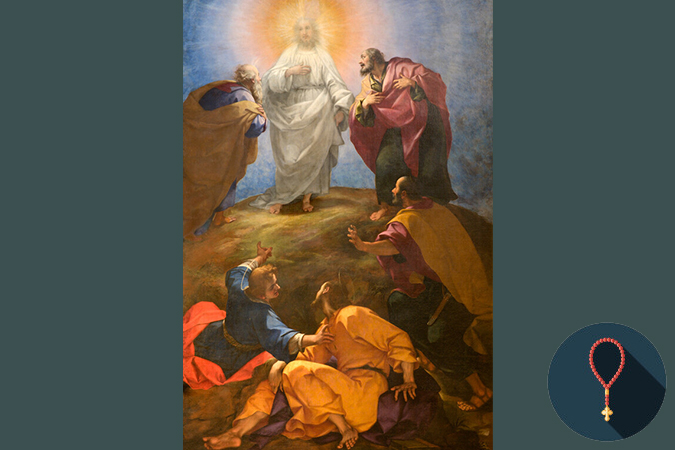
We continue our series of reflections on the Luminous Mysteries of the Rosary. Today, we reflect on the fourth Mystery of Light: the Transfiguration of Jesus.
In the story of Jesus’ Transfiguration (Matthew 17:1–9), we, along with Peter, James, and John, get a glimpse of Jesus revealed in all his glory—a glimpse of what awaits at his Resurrection.
Each of us is walking around with a vision of a hoped-for reality—an alternate reality—for ourselves, for those we love, for our community, and for our world. We imagine a world that exists somewhere beyond what our eyes can presently see. We have a choice: we can either approach life as a problem to be solved, a contest to be won, or as a mystery to be entered into more deeply. Without that drive for “the more,” life is little more than a frustrating problem we can’t seem to solve or an absurd game that we can’t seem to win. With that drive for “the more,” life becomes a mystery that enfolds us.
St. Ignatius Loyola promoted the notion of magis (translated as “more”), a mindset that seeks to rise above expectations and strive for more, for others and for God. To proclaim faith in Jesus Christ is to trust in his promise of a new reality—a reality of new and everlasting life, a reality in which heaven and earth are intimately linked. The Transfiguration is a reminder that this reality has already broken into this world. We can catch glimpses of it if we have eyes of faith. And, knowing that God keeps his promises, we can live as a people of hope and imagination. Catechists seek to encourage others to recognize these glimpses of God’s glory and to invite others to serve as a lasting part of something greater than themselves.
Ultimately, the story of the Transfiguration is a story of hope and promise of the more that awaits us. We live in a world that too often tempts us to despair instead of hope. The Transfiguration reminds us that we are a people of confident hope (because the promise comes from a reliable source: the Risen Christ) and that it is our job to bring this hope into places of despair so that life may be transformed and have meaning. Christian hope recognizes and acknowledges pain and suffering (the perceived absence of God) but believes in a future that overflows into the present with the presence of God. Christian hope is buoyed by the seeds of a new world already taking shape in this life. It is a hope that energizes us to live differently and compels us to spread the word that life is indeed worth living.
We are called to be voices of hope, which means that we too must listen for voices of hope. In the story of the Transfiguration, a voice from heaven tells Peter, James, and John: “This is my Son, whom I have chosen; listen to him.” (Luke 9:35) The Transfiguration of Jesus was a moment of focus and clarity for Peter, James, and John, when they heard God speaking to them and experienced Jesus Christ in glory. We are invited to consider our attentiveness to the voice of God and to voices of hope that echo God’s Word so that we may also echo words of hope to a world too often mired in despair. Let us pray for eyes to see the more that God promises to us and for voices to proclaim this good news to the world!
Deepen your understanding of the Rosary by reading The Rosary: A Path into Prayer by Elizabeth M. Kelly and The Complete Rosary: A Guide to Praying the Mysteries by William G. Storey.





Be the first to comment